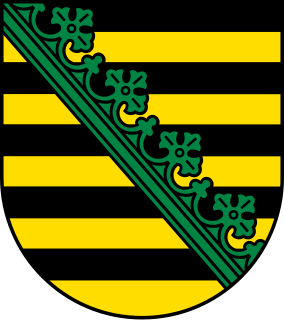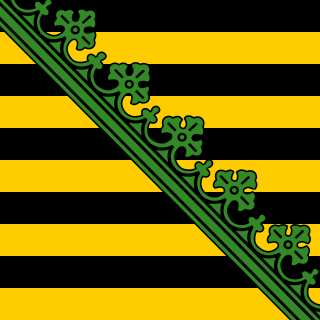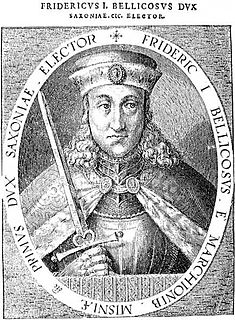
The history of Saxony-Anhalt began with Old Saxony, which was conquered by Charlemagne in 804 and transformed into the Duchy of Saxony within the Carolingian Empire. Saxony went on to become one of the so-called stem duchies of the German Kingdom and subsequently the Holy Roman Empire which formed out of the eastern partition of the Carolingian Empire. The duchy grew to become a powerful state within the empire, ruling over much of what is now northern Germany, but following conflicts with the emperor it was partitioned into numerous minor states around the end of the 12th century.

The House of Wettin is a dynasty of German counts, dukes, prince-electors and kings that once ruled territories in the present-day German states of Saxony, Saxony-Anhalt and Thuringia. The dynasty is one of the oldest in Europe, and its origins can be traced back to the town of Wettin, Saxony-Anhalt. The Wettins gradually rose to power within the Holy Roman Empire. Members of the family became the rulers of several medieval states, starting with the Saxon Eastern March in 1030. Other states they gained were Meissen in 1089, Thuringia in 1263, and Saxony in 1423. These areas cover large parts of Central Germany as a cultural area of Germany.

Saxe-Altenburg was one of the Saxon duchies held by the Ernestine branch of the House of Wettin in present-day Thuringia. It was one of the smallest of the German states with an area of 1323 square kilometers and a population of 207,000 (1905) of whom about one fifth resided in the capital, Altenburg. The territory of the duchy consisted of two non-contiguous territories separated by land belonging to the Principality of Reuss. Its economy was based on agriculture, forestry, and small industry. The state had a constitutional monarchical form of government with a parliament composed of thirty members chosen by male taxpayers over 25 years of age.

Saxe-Coburg was a duchy held by the Ernestine branch of the Wettin dynasty in today's Bavaria, Germany.

Ernest was Elector of Saxony from 1464 to 1486.

Saxe-Weimar was one of the Saxon duchies held by the Ernestine branch of the Wettin dynasty in present-day Thuringia. The chief town and capital was Weimar. The Weimar branch was the most genealogically senior extant branch of the House of Wettin.

Saxe-Eisenach was an Ernestine duchy ruled by the Saxon House of Wettin. The state intermittently existed at three different times in the Thuringian region of the Holy Roman Empire. The chief town and capital of all three duchies was Eisenach.

The Margravate of Meissen was a medieval principality in the area of the modern German state of Saxony. It originally was a frontier march of the Holy Roman Empire, created out of the vast Marca Geronis in 965. Under the rule of the Wettin dynasty, the margravate finally merged with the former Duchy of Saxe-Wittenberg into the Saxon Electorate by 1423.

The Ernestine duchies, also known as the Saxon duchies, were a changing number of small states that were largely located in the present-day German state of Thuringia and governed by dukes of the Ernestine line of the House of Wettin.

The Electorate of Saxony was a state of the Holy Roman Empire established when Emperor Charles IV raised the Ascanian duchy of Saxe-Wittenberg to the status of an Electorate by the Golden Bull of 1356. It comprised a territory of some 40,000 square kilometers. Upon the extinction of the House of Ascania, it was feoffed to the Margraves of Meissen from the Wettin dynasty in 1423, who moved the ducal residence up the river Elbe to Dresden. After the Empire's dissolution in 1806, the Wettin Electors raised Saxony to a territorially reduced kingdom.

The Duchy of Saxe-Wittenberg was a medieval duchy of the Holy Roman Empire centered at Wittenberg, which emerged after the dissolution of the stem duchy of Saxony. The Ascanian dukes prevailed in obtaining the Saxon electoral dignity until their duchy was finally elevated to the Electorate of Saxony by the Golden Bull of 1356.

The Saxon Eastern March was a march of the Holy Roman Empire from the 10th until the 12th century. The term "eastern march" stems from the Latin term marchia Orientalis and originally could refer to either a march created on the eastern frontier of the East Frankish duchy of Saxony or another on the eastern border of the Duchy of Bavaria: the Bavarian marchia Orientalis, corresponding to later Austria.

Henneberg was a medieval German comital family (Grafen) which from the 11th century onwards held large territories in the Duchy of Franconia. Their county was raised to a princely county in 1310.

The March or Margraviate of Lusatia was as an eastern border march of the Holy Roman Empire in the lands settled by Polabian Slavs. It arose in 965 in the course of the partition of the vast Marca Geronis. Ruled by several Saxon margravial dynasties, among them the House of Wettin, the lordship was contested by the Polish kings as well as by the Ascanian margraves of Brandenburg. The remaining territory was finally incorporated into the Lands of the Bohemian Crown in 1367.

The coat of arms of the present-day German free state of Saxony shows a tenfold horizontally-partitioned field of black (sable) and gold/yellow (or) stripes, charged with a green (vert) crancelin running from the viewer's top-left to bottom-right. Although the crancelin is sometimes shown bent (embowed) like a crown, this is due to artistic license. The coat of arms is also displayed on the state flag of Saxony.

The Division of Altenburg was the plan for the division of the Meissen lands agreed upon by the two hostile Wettin brothers Elector Frederick II of Saxony and William III on 16 July 1445 at Altenburg. The brothers had attempted to reconcile, but eventually the division led the Saxon Fratricidal War, which began in 1446 and lasted for five years, until the Peace of Naumburg was negotiated in 1451. Following the peace, the subsequent Treaty of Eger in 1459, and the deaths of Frederick II and Wilhelm III, the two sons of Frederick II eventually gained control of the land of both their father and William III.

The Saxon Fratricidal War was a war fought between the two brothers Frederick II, Elector of Saxony and Duke William III over Wettin ruled areas from 1446 to 1451. After a dispute over the division of certain family lands between Frederick II and William III, the Division of Altenburg eventually led to growing tensions between the two brothers and an inability to agree on who ruled which areas. After failed attempts at reconciliation, the war broke out and lasted for five years. The war was destructive and had no clear winner before being ended with a peace treaty at Naumburg. Following the war and subsequent divisions the Saxons lost much of their former power and influence within the different German states and families.
The Duchy of Thuringia was an eastern frontier march of the Merovingian kingdom of Austrasia, established about 631 by King Dagobert I after his troops had been defeated by the forces of the Slavic confederation of Samo at the Battle of Wogastisburg. It was recreated in the Carolingian Empire and its dukes appointed by the king until it was absorbed by the Saxon dukes in 908. From about 1111/12 the territory was ruled by the Landgraves of Thuringia as Princes of the Holy Roman Empire.
















